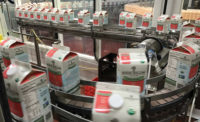If Frank Otis could add four to five days more shelf life to his organic milk, it would mean a world of difference. The CEO of Crystal Creamery, Modesto, Calif., said he could then service accounts in Los Angeles, 300 miles to the south.
“I can handle the state of California, which is as large as two or three countries in some parts of the world,” he said.
Crystal Creamery is investing in extended shelf life equipment at its dairy processing plants in Modesto and in Humboldt, Calif. (See related article) When Otis talks about extending shelf life, he means using a high-temperature/short-time pasteurizer, not ultra-pasteurization for refrigerated product and not aseptic processing in shelf-stable bottles.
Why does Otis prefer to use a high temperature/short time pasteurizer instead of ultra-pasteurizing at higher heat? It’s because organic consumers are “pretty sophisticated,” Otis said. When they see a 65-day shelf-life on a carton of organic milk, they ask questions like: How fresh can this be? Where is this coming from? How local is this? How organic is this? When they see a 21-day shelf life, they say, “Okay, this is a local product. It’s fresh,” Otis said.
There is no international standard or definition of extended shelf life, according to Tetra Pak, which this year published a white paper on the subject. The international supplier of processing equipment and packaging defines it this way: “ESL represents the shelf life of a chilled distributed product extended beyond limits of a conventional pasteurized product present in a specific market.”
Extending the shelf life of dairy products has many advantages, besides expanding a dairy’s trading area (which is no small advantage). Evergreen Packaging, another equipment and packaging supplier, wrote a white paper of its own in 2014. It notes these additional benefits of manufacturing extended shelf life fluid milk products:
- Increased plant efficiency through longer production runs
- Reduced distribution costs with fewer but larger deliveries to distant markets
- Reduced product returns from expired short-term pull dates
- Increased retail facings due to longer pull dates, which boost consumer purchases
- Increased sales, because consumers equate longer pull dates with freshness
- Enhanced brand building
When processing ESL products, dairies should adhere to basic aseptic principles, Evergreen writes. “Processing systems should be designed to aseptic standards even though the product is refrigerated.”
ESL fillers won’t improve the quality of the milk flowing into the equipment. But they can deteriorate its quality. “A packaging machine can only preserve the microbiological state of the product it is given; it cannot increase the quality or shelf life of the packaged product,” according to Evergreen.
The company distinguishes aseptic products from “extended long life” products. “Extended life production does not have to meet the same strict regulations that aseptic technology does. While the ultra-pasteurized product is close to aseptic standards, it is not considered to be commercially sterile. There is the potential to have different types of organisms at low levels in the finished product.”
“Raw milk quality is the first prerequisite for good ESL quality,” states Tetra Pak in its white paper. It also notes that “ESL technology is only as strong as the weakest link in the chain. In a filling machine used in connection with an ESL processing solution, everything that can come in contact with the product needs to be disinfected or sterilized, even the air in the filling chamber.”
A combination of hydrogen peroxide spray and high-energy UV light are typically used to disinfect or sterilize packaging materials. Blowing in HEPA-filtered air prevents other air from entering and enables all filling and sealing operations to be performed in a high-hygiene environment, according to Tetra Pak.
Post-processing handling is important, too. Evergreen notes that post-process contamination is a major cause of reduced shelf life. And as Tetra Pak notes, “Even though ESL products are better suited for a potential temperature abuse than standard pasteurized products, only a stable chilled distribution chain will preserve them. If such a chain is not possible, there is one more solution available – UHT and aseptic processing.”
For further study
- Download “Shelf Life of Refrigerated Products” at the Evergreen Packaging website. http://tinyurl.com/zp8erpo
- Download “Extending the shelf life of low-acid liquid dairy products for added value” at the Tetra Pak website. http://tinyurl.com/gtm4qpj




